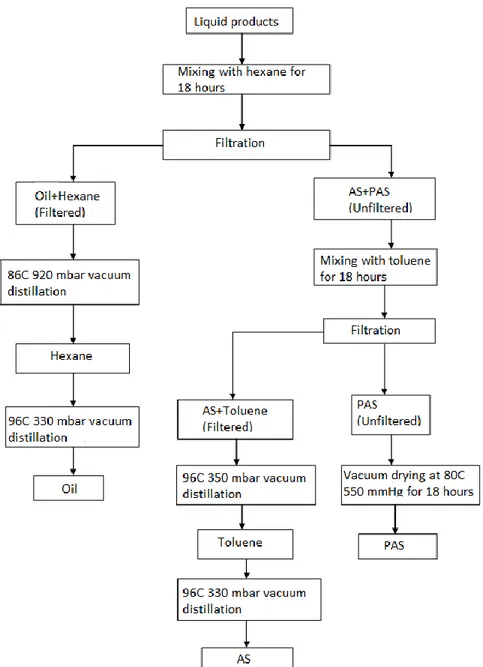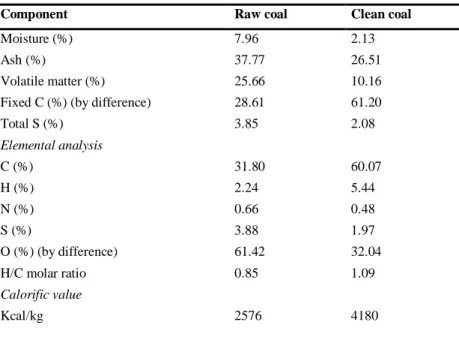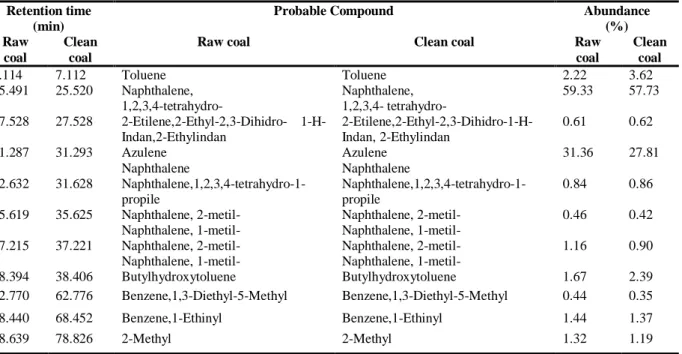A- APPLIED SCIENCES AND ENGINEERING
2019, 20(4), pp. 406 - 412, DOI: 10.18038/estubtda.499819
A STUDY ON THE INVESTIGATION OF IMPROVEMENT IN COAL LIQUEFACTION PRODUCT EFFICIENCY
Aydan AKSOĞAN KORKMAZ1,*
, İsmail BENTLİ2
1 Department of Mining Technology, Malatya Turgut Özal University, Malatya, Turkey 2 Department of Mining Engineering, İnönü University, Malatya, Turkey
ABSTRACT
The aim of this study is to improve the yields of Malatya-Arguvan lignite liquefaction products (char, preasphaltene, asphaltene, oil-gas). For this purpose, the liquefaction experiments of coal which was firstly raw and then enriched by spiral have been carried out. The chemical characterizations of the obtained products have been determined by proximate and ultimate analysis. The composition of the oil was identified by GC-MS. As a result of the enrichment, the char yield decreased by 9.28% whereas the preasphaltene yield increased by 5.31% and the oil + gas yield increased by 4.18%. Total conversion increased from 47.57% to 56.85%. It has been concluded that the enrichment process has a positive effect on the liquefaction yields.
Keywords: Liquefaction, Lignite, Asphaltane, Preasphaltane, Char, Oil
1.INTRODUCTION
According to the Energy Current Policies Scenario in of the International Energy Agency; increase rates for energy resources in 2017-2040 period; 42.8% in coal, 49.5% in natural gas, 16.9% in oil, 73% in nuclear, and 124.7% in renewable energy and others. Therefore, it is seen that the position of coal in the world energy supply will not change in the next 20 years [1].
The current reports of the MTA (Mineral Exploration and Exploration) indicate that the total coal resources in Turkey (including lignite, asphaltite and hard coal) is 18.77 billion tons. As one third of the coal resources of our country have been completed the feasibility studies, only a small part of them are considered as reserves [2].
Because of the organic and inorganic compounds contained in coal, it is important not only to meet the energy need but also to be a source of chemical raw materials. For this reason, various processes such as pyrolysis and liquefaction have been tried to produce solid and liquid fuels or chemical raw materials from coal. There are many studies on this subject in the literature [3-9].
The structure of coal is different from that of the hydrocarbons in petroleum. The principal difference between coal and petroleum is due to the lower H/C ratio of coal. Therefore, to convert coal into liquid products it is necessary to increase the H/C ratio in the products compared with the original coal. This is accomplished by direct hydrogenation or by removal of carbon. Indirect liquefaction processes involve the gasification of coal in a fixed or fluidized bed reactor followed by conversion of the synthesis gas into liquid hydrocarbons. Catalytic liquefaction processes are carried out in the presence of active catalysts to produce hydrocarbons directly, and the rehydrogenation of solvents occurs in-situ. When a catalysts is not used, the process is usually known as solvent extraction. Solvent extraction has been used for many years as a useful method to investigate coal structure. In catalytic and non-catalytic processes, coal is slurried in a coal derived solvent and heated to 400-500°C for varying lengths of time. Since, in non-catalytic processes, coal minerals may also play the role of catlyst, and both processes are
essentially hydroliquefaction processes, the distinction between the two processes is actually not justified [10].
The material extracted from coal may be separated into various fractions according to its solubility in a particular solvent (such as hexane, toluene, THF). It was decided to use the classification of oils (soluble in hexane), asphaltenes (soluble in toluene) and preasphaltenes (insoluble in toluene) for this study [11, 12].
In the present study, liquefaction studies have been carried out non-catalytic conditions in nitrogen gas atmosphere. The effect of the enrichment process of the liquefaction products were investigated by comparing the product yields.
In the literature, there are some investigations related with the liquefaction product yields of the lignite [13-18]. However, the effect of the enrichment in liquefaction process on the properties of the obtained products has not been fully studied yet.
2. MATERIALS AND METHODS 2.1. Material
The lignite sample used in this research was acquired from Arguvan-Malatya, which is located in the Eastern Anatolia of Turkey. The lignite samples are prepared according to the ASTM standards (ASTM D3173, ASTM D3174 and ASTM D3175) for gross calorific value, proximate and elemental analysis.
2.2. Method
The spiral tests were performed using by Reichert spiral with 5-launders. The tests have been done at different size fractions (-3.35+2, -2+1.18 and -1.18+0.15 mm), solid/liquid ratio (7.5, 15, 25 and 35% solid by wt.) and splitter settings (90, 120 and 150°). The cleanest coal obtained as a result of these experiments was used for liquefaction [19].
The samples were ground and the -106 micron size fraction was employed for liquefaction. Tetrahydrofuran (Merck, 99.0%), tetralin (Merck, 98%), n-hexane (Riedel-de Haen, 95%), toluene (Riedel-de Haen, 99.7%), ethylene glycol (EG), acetone, and ethanol were used in the present study. Liquefaction experiments were done using a mechanically stirred and electrically heated closed system 500 cm3 stainless-steel Parr reactor (PARR-USA Brand Model 4575). For each experiment, 30 g of the coal were put into the Parr autoclave and 90 cm3 of tetralin (C
10H12) without any catalyst was added on
it, and the autoclave was sealed and the pressure was adjusted to 20 bar by N2. Autoclave was heated at
about 3-4 °C/min and waited for 2 hours at 400 °C. It was mixed at constant speed of 400 rpm during both heating and reaction. The autoclave was heated until 400°C at 60 min, and then cooled to the room temperature into an ice-water bath. The char, asphaltene (AS), preasphaltene (PAS), and oil were separated from each other using the Soxhlet solvent extraction and evaporator system. The flow chart for the classification of coal dissolution products is given in Figure 1. Total conversions of liquefaction products were calculated according to the results of solvent extraction and char yields. The effect of the enrichment on the properties of the liquefaction products and oil yield were determined using mass balance equations.
Characterization and chemical structure of the liquefaction products have been determined using CHNS Elemental analyzer device (Leco CHNS 932, LECO Corporation, St. Joseph, MI), IKA C-1 calorimeter, Agilent Technologies 6890 N Network GC System model gas chromatography, and Agilent Technologies 5973 inert Mass Selective Detector mass spectrometer (Agilent Technologies, Santa Clara, CA) at the laboratory of Inonu University Scientific and Technology Center Research.
Figure 1. Flow chart of coal liquefaction products
3. RESULTS AND DISCUSSION
The results of the proximate and elemental analysis of raw and clean coal of Arguvan lignite and char are given in Table 1 and Table 2, respectively.
As it is seen from Table 1, raw coal contains 37.77% ash and 28.61% fixed carbon (on air dried basis). The gross calorific value of the raw coal was determined as 2576 kcal/kg, whereas clean coal contains 26.51% ash and 61.20% fixed carbon. The gross calorific value of the clean coal was determined as 4180 kcal/kg. The results of raw coal analysis are consistent with the research results in the literature [20].
Table 1. Proximate and elemental analysis results of raw and clean coal of Arguvan lignite (on air dried basis)
Component Raw coal Clean coal
Moisture (%) 7.96 2.13
Ash (%) 37.77 26.51
Volatile matter (%) 25.66 10.16
Fixed C (%) (by difference) 28.61 61.20
Total S (%) 3.85 2.08 Elemental analysis C (%) 31.80 60.07 H (%) 2.24 5.44 N (%) 0.66 0.48 S (%) 3.88 1.97 O (%) (by difference) 61.42 32.04 H/C molar ratio 0.85 1.09 Calorific value Kcal/kg 2576 4180
Table 2. The proximate analysis results of the char of raw and clean coal
Char Raw coal Clean coal
Ash (%) 20.11 10.88
Volatile matter (%) 27.03 23.81
Fixed C (%) (by difference) 52.86 65.31
According to the data given in Table 2, raw coal char contains 20.11% ash and 52.86% fixed carbon. Clean coal char contains 10.88% ash and 65.31% fixed carbon. These ash and fixed C values are quite good compared to raw coal.
The elemental analysis results of the liquefaction products (char, preasphaltane and oil) of raw and clean coal are given in Table 3. Elemental analysis and calorific values of asphaltene products can not be determined due to the difficulty of removing them from glass systems and the amount of material is small.
As it is seen from Table 3, there was an increase in the fixed carbon and calorific values of all liquefaction products in clean coal. However, it has been determined that all products have an increase in H/C ratios.
Therefore, it can be said that the enrichment process has a positive effect on liquefaction products.
In Table 4, the yields and total conversions of the products obtained as a result of liquefaction of raw and clean coal are given.
Table 3. Elemental analysis results of the liquefaction products of raw and clean coal Raw coal char Clean coal char Raw coal preasphaltane Clean coal preasphaltane Raw coal oil Clean coal oil Elemental analysis (%) C 54.16 66.75 69.02 73.28 70.30 79.13 H 4.59 6.72 5.44 7.57 6.94 8.15 N 1.39 1.30 1.21 1.33 0.42 0.33 S 2.92 2.03 1.05 0.78 0.44 0.28 O 36.94 23.20 23.28 17.04 21.90 12.11 H/C 1.02 1.21 0.95 1.24 1.19 1.24
Calorific value (Kcal/kg)
8175 8389 8319 8549 4400 4638
Table 4. The yield and total conversions of the products obtained as a result of liquefaction of raw and clean coal
Yield (%) Char Preasphaltane Asphaltane Oil+Gas Total conversion
Raw coal 52.43 8.87 8.33 30.37 47.57
Clean coal 43.15 14.18 8.32 34.55 56.85
According to the data give in Table 4, while preasphaltane and oil+gas yields increased in clean coal, the asphaltane yield was unchanged. The total conversion of clean coal has increased from 47.57% to 56.85%. According to GC-MS analysis, chemical compounds of oils are given in Table 5. As it is seen from Table 5, the main compounds of the oil were determined as saturated n-alkenes, isoprenoids, branched alkenes, n-alkyl cyclohexane, terpene and other aromatic structures, like the literature data [12, 21-24]. As a result, it is determined that the enrichment process has a positive effect especially on the yield of the preasphaltene and oil + gas products. However, the enrichment was found to have no effect on the composition of the oil product.
Table 5. GC-MS analysis of the oil obtained from liquefaction of raw and clean coal and the detected compounds in the oil structure
Retention time (min)
Probable Compound Abundance
(%) Raw
coal
Clean coal
Raw coal Clean coal Raw
coal Clean coal 7.114 7.112 Toluene Toluene 2.22 3.62 25.491 25.520 Naphthalene, 1,2,3,4-tetrahydro- Naphthalene, 1,2,3,4- tetrahydro- 59.33 57.73 27.528 27.528 2-Etilene,2-Ethyl-2,3-Dihidro- 1-H-Indan,2-Ethylindan 2-Etilene,2-Ethyl-2,3-Dihidro-1-H-Indan, 2-Ethylindan 0.61 0.62 31.287 31.293 Azulene Naphthalene Azulene Naphthalene 31.36 27.81 32.632 31.628 Naphthalene,1,2,3,4-tetrahydro-1-propile Naphthalene,1,2,3,4-tetrahydro-1-propile 0.84 0.86 35.619 35.625 Naphthalene, 2-metil- Naphthalene, 1-metil- Naphthalene, 2-metil- Naphthalene, 1-metil- 0.46 0.42 37.215 37.221 Naphthalene, 2-metil- Naphthalene, 1-metil- Naphthalene, 2-metil- Naphthalene, 1-metil- 1.16 0.90 38.394 38.406 Butylhydroxytoluene Butylhydroxytoluene 1.67 2.39 62.770 62.776 Benzene,1,3-Diethyl-5-Methyl Benzene,1,3-Diethyl-5-Methyl 0.44 0.35 68.440 68.452 Benzene,1-Ethinyl Benzene,1-Ethinyl 1.44 1.37 88.639 78.826 2-Methyl 2-Methyl 1.32 1.19
3. CONCLUSION
As a conclusion, it can be said that in the liquefaction studies with raw coal, char yield was 52.43%, preasfaltene yield was 8.87%, asphaltene yield was 8.33% and oil + gas yield was 30.37%. As a result of the liquefaction of the clean coal, the char yield decreased by 9.28%, the preasphaltene yield increased by 5.31% and the oil + gas yield increased by 4.18%, while the asphaltene yield remained unchanged. Total conversion increased from 47.57% to 56.85% (Table 4).
It has been determined that all products have reduced sulfur content (Table 3). The calorific value of all products in clean coal have increased (for char from 8175 kcal/kg to 8389 kcal/kg, for preasphaltene from 8319 kcal/kg to 8549 kcal/kg, for oil from 4400 kcal/kg to 4638 kcal/kg).
According to GC-MS results, the main compounds of the oil were determined as naphthalene and its derivatives, tetraline, azulene, binaphthalene and benzen. In the oil of clean coal, no compounds were found that did not exist in raw coal. As it is seen from Table 4, the clean coal oil yield for liquefaction process was founded as 34.55% to be higher than the raw coal oil yield (30.37%). From these results, it has been found that the enrichment process has a strong positive effect on the liquefaction product yields, especially on the oil + gas and preasphaltene.
Finally, it has been suggested that the production of a more valuable product using the lignite having low calorific value is not only going to contribute more to the country's economy but also be better for the environment. However, it is clear that it is necessary to investigate the economics of the theoretically and practically possible liquefaction method.
ACKNOWLEDGEMENTS
This work was financially supported by the Inonu University Scientific Research Projects Coordination Unit. (Project number: BAP-2015-34)
REFERENCES
[1] Coal Information 2017, IEA 2018.
[2] MTA 2017 Annual Report, Ankara, MTA 2018.
[3] Lievens C, Ci D, Bai Y, Ma L, Zhang R, Chen J.Y, Gai Q. A study of slow pyrolysis of one low rank coal via pyrolysis-GC/MS. Fuel Processing Technology 2013; 116:85-93.
[4] Xu Y, Zhang Y, Wang Y, Zhang G, Chen L. Gas evolution characteristics of lignite during low-temperature pyrolysis. Journal of Analytical and Applied Pyrolysis 2013; 104:625-631.
[5] Meng F, Yu J, Tahmasebi A, Han Y, Zhao H, Lucas J, Wall T. Characteristics of chars from low-temperature pyrolysis of lignite. Energy Fuels 2013; 28:275-284.
[6] He Q, Wan K, Hoadley A, Yeasmin H, Miao Z. TG-GC-MS study of volatile products from Shengli lignite pyrolysis. Fuel 2015; 156:121-128.
[7] Li P, Zong Z.M, Liu F.J, Wang Y.G, Wei X.Y, Fan X, Zhao Y.P, Zhao W. Sequential extraction and characterization of liquefaction residue from Shenmu-Fugu subbituminous coal. Fuel Processing Technology 2015; 136:1-7.
[8] Rahman M, Adesanwo T, Gupta R, Klerk A. Effect of direct coal liquefaction conditions on coal liquid quality. Energy and Fuels 2015; 29:3649-3657.
[9] Kanca A, Dodd M, Reimer J.A, Uner D. Following the structure and reactivity of Tunçbilek lignite during pyrolysis and hydrogenation. Fuel Processing Technology 2016; 152:266-273.
[10] Kural O. Coal Resources, Properties, Utilization, Pollution. Istanbul, Turkey: Ozgun Press, 1994.
[11] Ekinci E, Yardim F, Razvigorova M, Minkova V, Goranova M, Petrov N, Budinova T. Characterization of liquid products from pyrolysis of subbituminous coals. Fuel Processing Technology 2002; 77-78:309-315.
[12] Karaca H, Koyunuoğlu C. The co-liquefaction of Elbistan lignite and biomass Part II: The characterization of liquefaction products. Energy Sources, Part A: Recovery, Utilization and Environmental Effects 2010; 32:1167-1175.
[13] Gözmen B, Artok L, Erbatur G, Erbatur O. Direct liquefaction of high-sufur coals: effects of the catalyst, the solvent and the mineral matter. Energy and Fuels 2002; 16:1040-1047.
[14]Hesenov A, Gül Ö, Gafarova P, Erbatur O, Schobert H.H. Distribution of main product fractions in co-liquefaction of high-sulfur lignites blended with petroleum heavy bottoms. Prepr.Pap.-Am.Chem.Soc., Div.Fuel Chem. 2004; 49:500-502.
[15] Gül Ö, Gafarova P, Hesenov A, Schobert H.H, Erbatur O. Catalytic direct liquefaction of high sülfür lignites: temperature and solvent effect on product distributions. Prepr.Pap.-Am.Chem.Soc., Div.Fuel Chem. 2004; 49:559-561.
[16] Omais B, Courtiade M, Charon N, Thiebaut D, Quignard A. Characterization of oxygenated species in coal liquefaction products: An overview. Energy and Fuels 2010; 24:5807-5816.
[17] Li X, Xue Y, Feng J, Yi Q, Li W, Guo X, Liu K. Co-pyrolysis of lignite and Shendong coal direct liquefaction residue. Fuel 2015; 144:342-348.
[18] You Q, Wu S.Y, Wu Y.Q, Huang S, Gao J.S, Shang J.X, Min X.J, Zheng H.A. Product distributions and characterizations for integrated mild-liquefaction and carbonization of low rank coals. Fuel Processing Technology 2017; 156:54-61.
[19] Aksoğan Korkmaz A. The effects of enrichment methods on pyrolysis product yields obtained from different lignites. Ph.D.Thesis, Inonu University, Malatya, Turkey, 2017.
[20] İçel İlhan. Malatya-Arguvan tertiary basin lignite prospecting report. MTA Reports, Ankara, 1988.
[21] Speight J.G. The Chemistry and Technology of Coal. 2nd ed. New York, NY, USA: Marcel Dekker Inc., 1994.
[22] Methakhu, S, Ngamprasertsith S, Prasassarakich P. Improvement of oil yield and its distribution from coal extraction using sulfide catalysts. Fuel 2007; 86:2485-2490.
[23] Karaca H, Koyunuoğlu C. Co-liquefaction of Elbistan lignite and biomass Part I: The effect of the process parameters on the conversion of liquefaction products. Energy Sources, Part A: Recovery, Utilization and Environmental Effects 2010; 32:495-511.
[24] Wang Z, Shui H, Pan C, Li L, Ren S, Lei Z, Kang S, Wei C, Hu J. Structural characterization of the thermal extracts of lignite. Fuel Processing Technology 2014; 120:8-15.


